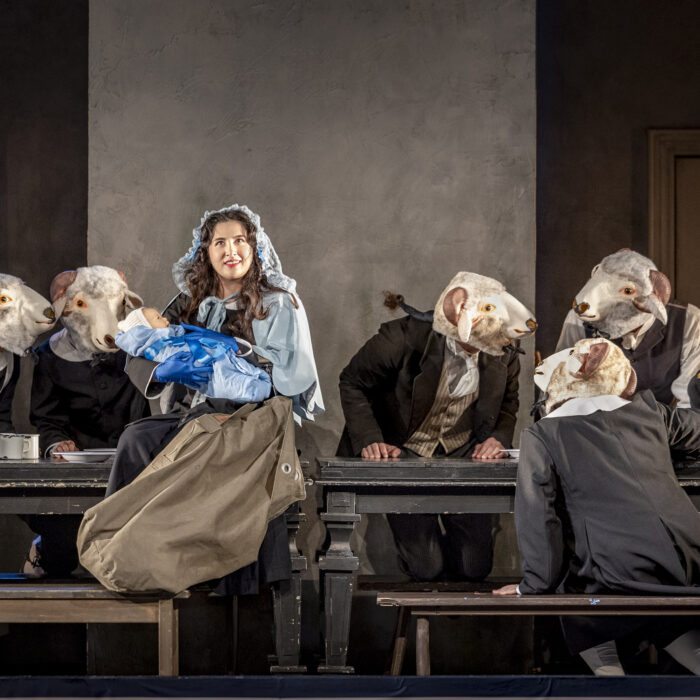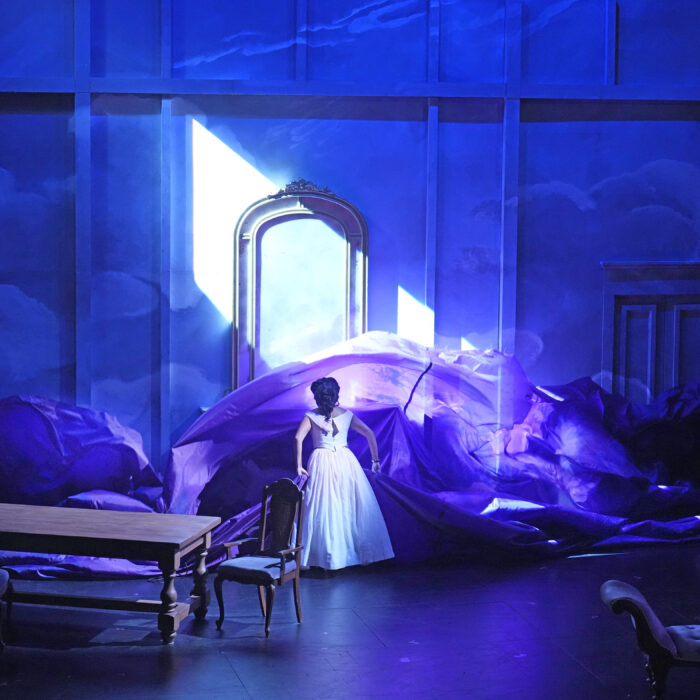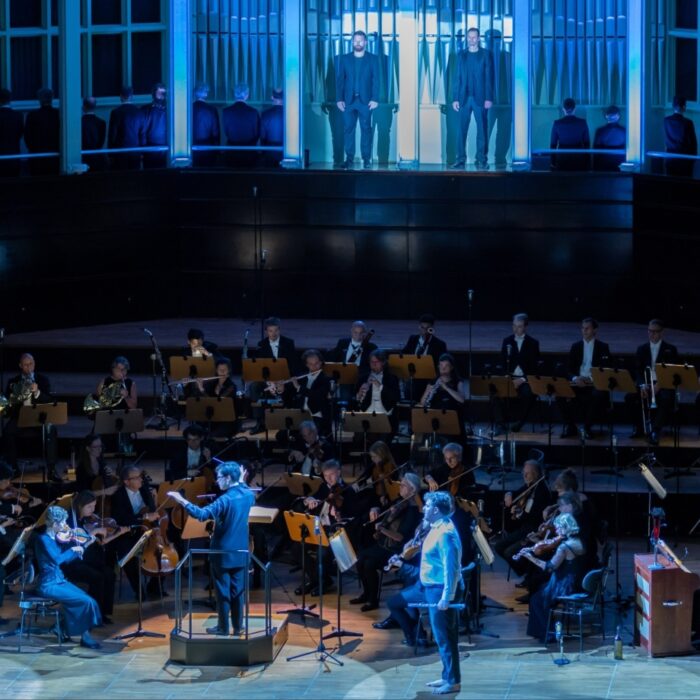
Lyric Opera of Chicago 2023-24 Review: Aida
By Benjamin TorbertThough the most iconic grand opera in the art form’s canon, Verdi’s “Aïda” shouldn’t challenge a house of Lyric’s caliber too strenuously. The work requires four good-to-great singers, but we expect a top-five American opera house to arrange them. Though “Aïda” lends itself to maximalist stagings, smaller companies pare it down successfully by foregoing equestrian participants, or downshifting parades to processions. Lyric rosters a fine chorus and possesses the real estate in which to install impressive sets. Even in the current fiscal headwinds, one would expect Lyric to handle a big show with relative facility. But this “Aïda” (seen 26 March 2024) failed conclusively as a staging, mitigated only intermittently by musical delights.
Misreading the Room
Would that Lyric had managed a better sendoff for retiring General Director, Anthony Freud. Peculiarly, the company marketed Verdi’s late masterpiece with maestro Enrique Mazzola’s lack of experience leading it, touting his first encounter with this repertory warhorse as a selling point. But, Mazzola had previously led 99 operas, so what’s one more?
Less sensibly, the production notes also postured as some sort of flex the visual artist RETNA’s complete inexperience with stage design in opera, or with opera at all, by his own admission. For experience, we look to veteran director Francesca Zambello, who has already exposed audiences to this production at Washington National Opera, Los Angeles Opera, and San Francisco Opera, apparently learning nothing about advocating persuasively for it meanwhile. In a brief but cliché-dense essay—“Aïda” apparently forms “part of the fabric of [her] being”—she advanced the notion that “Aïda” is a “chamber opera” that just happens to include one monumental scene in Act II. At least two grave problems with that reading immediately become obvious. First, Zambello misread genre, especially musically. Chamber operas employ small orchestral forces and don’t include massive choruses. Set aside the triumphal scene: chamber operas lack anything structured like the temple scene in “Aïda,” the judgment scene, or the concertato ending the first scene. They don’t generally require five to seven distinct sets in four acts. But far worse, Zambello centralized this misreading of genre, as though it conceptually unified the staging.
It doesn’t. Zambello would have us believe that concentrating on “the four individual dramas” comprises some novel approach. No, this composer’s fundamental dramatic tool is juxtaposing the personal and the public, placing them in conflict with each other. It’s his main move. Verdi’s characters live in a society, in a time, in a place—update it, or don’t, but pick somewhere and some time. Unlike Wagner, he doesn’t pair up isolated maritime lovers who enjoy making love by mellifluously rapping adulterated Schopenhauer to each other. His characters answer to civilizations and their authorities. As Verdi aged, he improved even further at this formal personal/public relation, peaking with “Don Carlo(s),” “Aïda” and “Otello,” executing it in strikingly nuanced ways. This dynamic animates every single Verdi opera, and arguably, even his Requiem—it’s there in the Requiem’s music. The personal relationships between the principal characters in their public setting are a given, and their importance doesn’t rate some keen insight into “Aïda” in particular, nor does the idea anchor a staging of the work.
“This opera lives in a world of emotions,” observes Zambello. Students in introductory writing classes ply instructors with equally blurry so-called insights. “In setting the work in a more abstracted location, I am intending to make a strong connection between our current vocabulary and this ancient story.” What current vocabulary? Whose? What does that mean? Neither does ‘ancient’ accurately describe the story, which scholarship attributes variably to Auguste Mariette (d. 1881), or in alpha Verdi biographer Mary Jane Philip-Matz’s account, Temistocle Solera (d. 1878). In either case, Antonio Ghislanzoni’s libretto shares no more with actual Egyptian antiquity than the Bangles’ “Walk like an Egyptian.” “Aïda” remains a plainly 19 century text, featuring no ancient anything, past the priests’ unwillingness to consider Radamès’ good intent as a counterbalance to his guilt. In “Aïda,” Egypt and Ethiopia function in the context of 19 century European nationalism.
New operagoers might plausibly be misled by such handwaving, but experienced Verdi audience will see through Zambello’s transparent nonsense. Her sophomoric staging reflected her incoherent verbal takes on the opera.
RETNA’s calligraphs crash-landed into Michael Yeargan’s sets and presented no coherent semiotic connection to the opera. Anita Yavich’s costume design combined a smorgasbord of looks without discernable intentionality. Cast spent much of the opera standing apart, or looking past each other, but in a scattershot fashion, rather than purposefully as in, say, Robert Wilson’s 1990s “Lohengrin.” And risible choreography torpedoed each scene featuring dance. Excepting the set for the Tomb Scene, nearly every element of the production appeared hastily thrown together. (More on which, below). Well, it’s Verdi, so at least we get smoldering singing? Enjoyment of this performance leaned heavily on the musicmaking.
Principessa
In the title role, soprano Michelle Bradley excelled the other principals throughout the performance; Lyric’s was an Aïda’s “Aïda,” so to speak. Her instrument stands near the boundary between lirico-spinto and dramatic, larger than her castmates’ and easily filling the Civic Opera House’s yawning 3600-seat maw. She gave a superior performance to the last time your reviewer heard her as Aïda, at the Metropolitan’s long goodbye to its slightly fusty but intensely beloved Sonja Frisell staging in the 2022-23 season. In Chicago her voice focused better. Despite her instrument’s size, Bradley’s best moments occurred in piano passages. Beginning her first aria “Ritorna vincitor” with a weepy timbre, she brought emotional complexity to the character with measured dynamic contrasts, especially retreating from the fortissimo high B♭ on “Ah! sventurata” to “che dissi?” an octave and a half below. At “mio padre, di catene avvinto,” she received a spotlight and the curtain dropped behind her, further advantaging her acoustically. She spun finely the thread of the first “numi, pietà,” immediately weaving it into soft but thicker cable with “del mio soffrir.” And she closed with a true morendo with the last C5. A masterclass in dynamic control.
Our Ethiopian princess rests for the temple scene and the judgment scene, but otherwise occupies the stage nearly all evening. Bradley paced herself superbly. She aurally contoured her disfavored state, building slowly in Act two’s duet with Amneris and coming to a head in a gorgeous “avversi sempre a me furo i numi.” Her “numi pietà” to close the duet sounded even prettier than the same phrase in Act one’s aria. She flew above the people in the triumphal scene’s hullabaloo. Act three’s “O patria mia” matched “Ritorna vincitor” in skill and in communicating the drama with her voice, with a steely top but a warm middle. Her chest carried strongly with “rivedrò” midway through. The final bars weren’t her strongest of the night, with a merely okay A♮, and she didn’t take the high C with “mai più,” but no matter. When you’re singing this well, you get some latitude. In the tomb scene, Bradley projected into the auditorium just as well as at the beginning of the performance, while Russell Thomas’ Radamès had less fuel remaining in his tank. One minor cavil: her Italian diction fluctuated—she and Thomas brought two different pronunciations of the same word, ‘ciel,’ simultaneously to their suffocation duet. His sounded more like Italian, hers some back vowel of anglophone provenance. But overall, Bradley’s Aïda provided most of the evening’s highlights.
As Aïda’s father, baritone Reginald Smith Jr played Amonasro more sympathetically than usual. Performance practice has oft racialized “Aïda,” casting the Egyptians as European-adjacent and the Ethiopians as othered and way Black, and in many stagings Amonasro presents uncomfortably close to a trickster stereotype in Act three. Smith’s booming baritone and urgent acting framed Amonasro as a brave counterinsurgent, attempting to fend off genocide. Though aged thirty-something, Smith has paved a lane in simulating much older men, the same composer’s Falstaff, and just weeks ago, senior Emile Griffith in Lyric’s very successful “Champion” by Terence Blanchard.
As with “Champion,” Smith began unsteadily in high register and rallied admirably with a mature sound as he continued. Outfitted with a tall right-angled cane due to a foot injured in rehearsals, he physicalized a sense of Ethiopian survival. His persuasion of Aïda to betray Radamès—Bradley genuinely bewildered by the very suggestion—reached its greatest intensity in the passage terrorizing her with the specter of her mother’s ghost. Smith struck the right tone of concern, paternal love, and righteous anger with his climactic pronouncement calling her a slave, “Non sei mia figlia! / Dei Faraoni tu sei la schiava!” as he crested on his anguished E♭. Ably complementing the principals were Alejandro Luévanos as the Egyptian Messenger and Kathryn Henry as the Priestess, the latter with a sound more mournful than sacramental in the temple scene.
La mia rival!
Contrasting Bradley’s masterful pacing, as Amneris, Jamie Barton mailed it in for most of the night. In retrospect, she saved everything for Act four’s judgment scene. Her underpowered chest lent a sopranistic color to Amneris as the instrument shone only in head voice, her middle and low registers sounding declamatory. She disappeared aurally in ensembles, and Bradley blew her doors off in the Act one trio and their duet in Act two. In the latter, Amneris came across as fake, bidding you to wonder why Aïda would be tricked by her deception about Radamès dying. Too, Barton’s acting frequently projected a petulant superiority positioning Amneris as the unquestioned antagonist of the story; “Aïda” functions much better if the audience can instead sympathize with all three in the love triangle, or if Radamès would plausibly face a hard decision in allotting his affection.
The end of Act four’s duet with Thomas displayed her first truly affecting singing of the evening, as “De’ miei pianti la vendetta or dal ciel si compirà” soared powerfully to the high B♭. But the cumulative effect of her performance neutralized her best moments, late, with an overwhelming sense of “where was this all night?” By Act four, her Amneris had finally achieved some rootability, and her closing prayers atop the tomb exhibited dignified presence absent from Acts one and two. Though Barton’s a gifted singer, judging from this and from Eboli in “Don Carlos,” at the Met two seasons ago, casting her in Verdi misdeploys her talents.
Tu non sei colpevole
Russell Thomas gave a variable performance as these women’s love interest Radamès, strong at times, but frequently sounding fatigued. Real talk: opera finds itself mired deep in a tenor crisis. Reasonable observers will differ on the severity and duration, depending on their level of pickiness or length of institutional memory, but there shouldn’t be much disagreement on the basics. Nature fails to gift us with many true dramatic or even lirico-spinto tenors, and unfortunately, many labor in pursuits other than music. Surely some potential Siegfried works as a bouncer in Berlin. A demand-supply imbalance incents unyielding pressure for up-gauging of fach, such that lyric tenors sing lirico-spinto roles, and spintos sing dramatic roles—and sometimes lyrics hop multiple steps up to dramatic roles. Top opera houses repeatedly cast into overuse the men who for a time thrive in this environment, until their instruments wear quickly. Then they push somebody else. Wash, rinse, repeat.
Russell Thomas has for years demonstrated reliability, displays keen musicianship, and qualifies as a man whom opera can ill-afford to lose to the over-faching malaise. Yet, warning signs have manifested. Thomas arrived in the Windy City just having set aside his Holy Grail from Houston Grand Opera’s “Parsifal,” the same bizarre John Caird “talk to the hand” staging that Lyric mounted a decade ago with Paul Groves, another tenor for whom that role probably lies just past the heaviest limits of feasibility. And then, Verdi administers a downright savage pop quiz three minutes in, with “Celeste Aïda.” Mazzola didn’t help Thomas with overloud brass for the recitative, and the tenor didn’t sound entirely warmed up. Thomas will unfailingly give you some pleasant overtones. But hollow piano moments, like the “aaah” on F♮ before the “Celeste Aïda” reprise, gave a raspy character resembling the current condition of Jonas Kauffmann’s voice, another sizable but not huge instrument which big Verdi and Wagner roles have roughed up. Mezzoforte worked better, and “tu sei regina” landed forcefully. While the final B♭ rang brilliantly, and fortissimo—does anyone honor the morendo in the score in the 21st century?—he cut it off more swiftly than I’ve ever heard anyone do. None of this was lousy, but one has higher expectations for Thomas.
From there, his up-and-down night continued. He held his own easily against debuting bass Önay Köse’s pedestrian, unnuanced Ramfis in the temple scene, but got shouty in spots to compete with the chorus, while Köse didn’t even bother. Köse’s uninspired Ramfis raised a question – why his casting wasn’t reversed with bass William Clay Thompson, who sounded far sturdier in the smaller role of the Egyptian King? WC Thompson’s powerful voice sounded regal. Intelligently, Russell Thomas rationed his resources for Radamès’ splashiest moments; “immenso Fthà” to close Act one, and also the most heavy metal ten seconds in Verdi’s whole score, “Sacerdote, io resto a te,” ending Act three, though he was strained before that in “Pur ti riveggo, mi dolce Aïda,” the duet with Bradley. Their voices didn’t really blend in the tomb scene. Very little erotic energy coursed between them, his presentation anhedonic, and Thomas’ wooden acting saw him often approximate his eyelids distractingly rather than eye-contacting his castmates.
Calligraphic Violence
Perhaps Thomas shielded his gaze from Zambello’s thoughtless staging. The last set, for the tomb scene, appeared both spare and intimate, and it suitably platformed Amneris for her final prayers, although Radamès exited life with his head on Aïda’s belly in an oddly Freudian posture. Elsewhere, the production simultaneously looked ugly and insulted the audience’s intelligence, over and over. Zambello set the action in—who knows, but you couldn’t tell from the sets or costumes. Anyone associated with the Egyptian military received a drab khaki uniform with a red cap, consistent with any number of mid-20th century postcolonial dictatorships. Poured haphazardly over this aesthetic, the women of the court among Amneris wore a rainbow of attractive but unrelated Persian or Indian subcontinental fabric. Barton got a couple of boxy caftans, electric blue and yellow, unconnected to any other visual elements. Ramfis and his priestly cohort sported vaguely Eastern Orthodox vestments, but with RETNA’s calligraphs affixed to their cylindrical headwear, incongruous and lopsided, like that absurd, internet meme-generating hat that Princess Beatrice wore to the British royal wedding in 2011.
Ballerina Anne O’Donnell Passero’s graceful movements in a lovely, flowy, golden gown clashed with the rest of the dance. She looked like she’d been kidnapped from “The Nutcracker,” deported to unidentified geography, and forced to perform for a motley assortment of calligraphy enthusiasts. Excepting Passero, every dance element forced the suppression of a guffaw. A Zambello commonplace is sprinkling some rowdy children on the stage; these kids were too old to be interested in the game of tag they played in the midst of Amneris’ handmaidens, cavorting about a misplaced mid-century modern sofa. The male dance squad emulated Monty Python’s ministry of silly walks, with somewhat more grace than John Cleese. They hijacked Passero’s ballet by forming a human trampoline, purposed to fire her into the air comically. One wonders how much responsibility for this farcical display to allot choreographer Jessica Lang, and how much rested with Zambello.
Nor is the contention that “Aïda” is a chamber opera a valid excuse to mangle the triumphal scene. In 2024, no, the audience doesn’t expect the pyramids of Giza or the British Museum, but please do produce some modicum of attractive spectacle. Instead, the Pharoah’s apparatchiks wheeled Radamès onstage atop a rickety gizmo, a pile of ladders that bade me fear for Thomas’ safety. Barton’s Amneris beamed with inexplicable delight at the festivities. Punctuating the triumphal scene, a deluge of confetti befitting a cocktail bar on New Year’s Eve rained on the participants. Act II’s goofy looks gave way to some relief in Act III, with the drops and banners and models and hats full of calligraphs largely absent, and some atmospheric liquid nitrogen crawling soothingly across the stage. But Act IV’s judgment scene returned to Act I’s expansive, fluorescent-lit police interrogation box, where, given Thomas’ ethnicity, the priests’ binding of Radamès with dark cloths gave a cringy whiff of photography of American lynchings. Had the production demonstrated any evidence of careful thought whatsoever, one would read that as a deliberate comment on human rights, but it emerged as just one more in a long volley of under-considered directorial spitballs. Audience behaved badly in spots, talking as the tomb scene began; hard to discern whether that was 21st century inattention, or an expression of boredom.
Basta. What of Mazzola’s debut in the work? A mixed bag, like much of the performance. The ethereal prelude and intro to Act one lacked developing weight in the lower strings, and muddy brass led a jerky crescendo. By and large, he did a good job of getting the orchestra out of the singers’ way for their big moments. He took the finale of the triumphal scene at a breakneck pace, at the cost of precision. Like Barton, the orchestra performed best in Act four, especially in the judgment scene, which is an all-time headbanger. After Bradley, Michael Black’s chorus was the musical star of the show, energizing every scene in which they appeared.
Lyric’s coming 2024-25 season combines Jeanine Tesori’s “Blue” with a slate of standard repertory hits. Hopefully, if updatings or concept productions refresh these classics—a good idea generally—these will include an actual concept, beyond an insistence on the opera belonging to a genre it does not. And fortunately, the Metropolitan mounts a brand new “Aïda” on New Years Eve 2024. Perhaps they can loan it to other A-level houses, so that no one need sit through Zambello’s production again.



